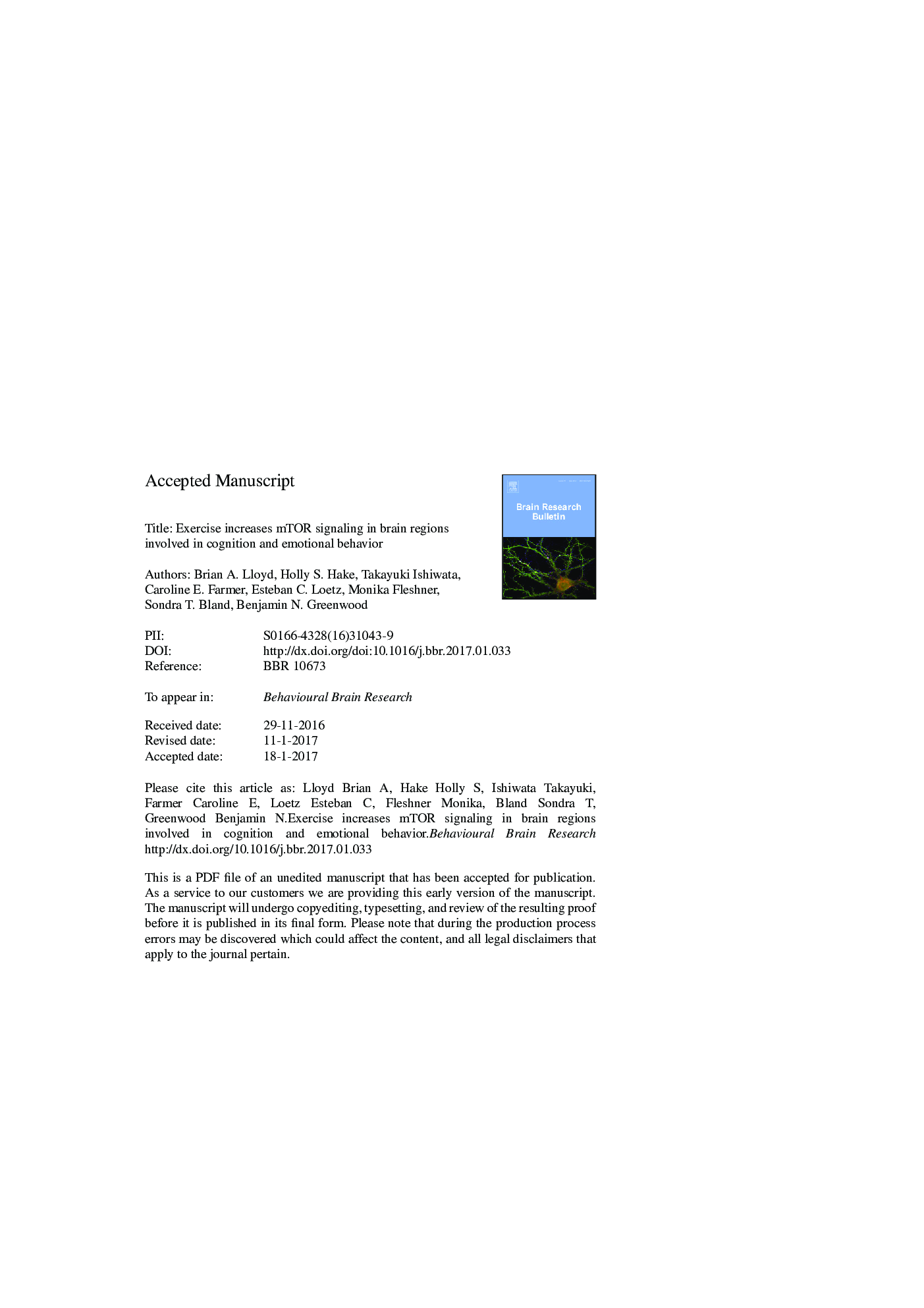| کد مقاله | کد نشریه | سال انتشار | مقاله انگلیسی | نسخه تمام متن |
|---|---|---|---|---|
| 5735624 | 1612911 | 2017 | 38 صفحه PDF | دانلود رایگان |
عنوان انگلیسی مقاله ISI
Exercise increases mTOR signaling in brain regions involved in cognition and emotional behavior
دانلود مقاله + سفارش ترجمه
دانلود مقاله ISI انگلیسی
رایگان برای ایرانیان
موضوعات مرتبط
علوم زیستی و بیوفناوری
علم عصب شناسی
علوم اعصاب رفتاری
پیش نمایش صفحه اول مقاله

چکیده انگلیسی
Exercise can enhance learning and memory and produce resistance against stress-related psychiatric disorders such as depression and anxiety. In rats, these beneficial effects of exercise occur regardless of exercise controllability: both voluntary and forced wheel running produce stress-protective effects. The mechanisms underlying these beneficial effects of exercise remain unknown. The mammalian target of rapamycin (mTOR) is a translation regulator important for cell growth, proliferation, and survival. mTOR has been implicated in enhancing learning and memory as well as antidepressant effects. Moreover, mTOR is sensitive to exercise signals such as metabolic factors. The effects of exercise on mTOR signaling, however, remain unknown. The goal of the present study was to test the hypothesis that exercise, regardless of controllability, increases levels of phosphorylated mTOR (p-mTOR) in brain regions important for learning and emotional behavior. Rats were exposed to 6 weeks of either sedentary (locked wheel), voluntary, or forced wheel running conditions. At 6 weeks, rats were sacrificed during peak running and levels of p-mTOR were measured using immunohistochemistry. Overall, both voluntary and forced exercise increased p-mTOR-positive neurons in the medial prefrontal cortex, striatum, hippocampus, hypothalamus, and amygdala compared to locked wheel controls. Exercise, regardless of controllability, also increased numbers of p-mTOR-positive glia in the striatum, hippocampus, and amygdala. For both neurons and glia, the largest increase in p-mTOR positive cells was observed after voluntary running, with forced exercise causing a more modest increase. Interestingly, voluntary exercise preferentially increased p-mTOR in astrocytes (GFAP+), while forced running increased p-mTOR in microglia (CD11+) in the inferior dentate gyrus. Results suggest that mTOR signaling is sensitive to exercise, but subtle differences exist depending on exercise controllability. Increases in mTOR signaling could contribute to the beneficial effects of exercise on cognitive function and mental health.
ناشر
Database: Elsevier - ScienceDirect (ساینس دایرکت)
Journal: Behavioural Brain Research - Volume 323, 14 April 2017, Pages 56-67
Journal: Behavioural Brain Research - Volume 323, 14 April 2017, Pages 56-67
نویسندگان
Brian A. Lloyd, Holly S. Hake, Takayuki Ishiwata, Caroline E. Farmer, Esteban C. Loetz, Monika Fleshner, Sondra T. Bland, Benjamin N. Greenwood,